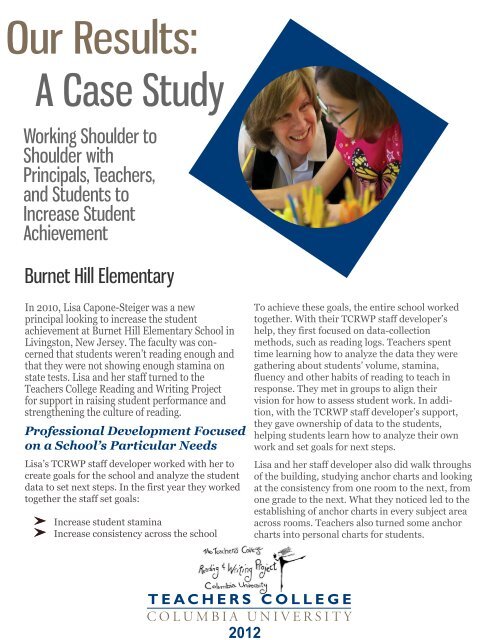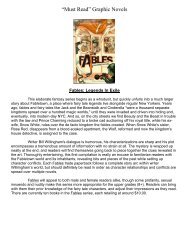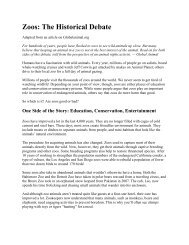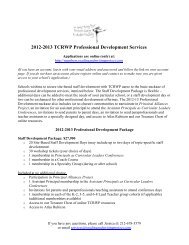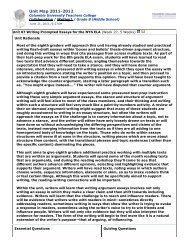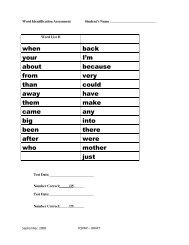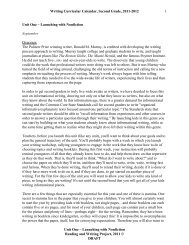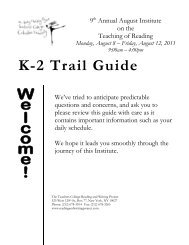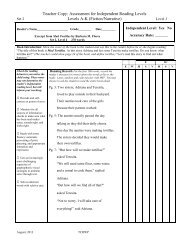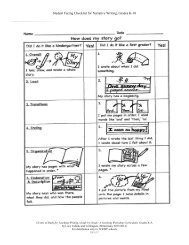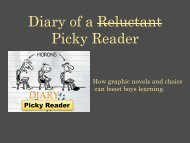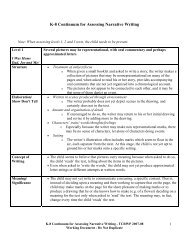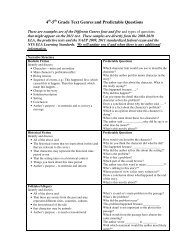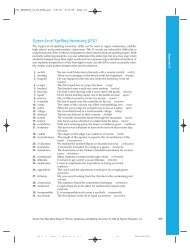Our Results: A Case Study - The Reading & Writing Project
Our Results: A Case Study - The Reading & Writing Project
Our Results: A Case Study - The Reading & Writing Project
You also want an ePaper? Increase the reach of your titles
YUMPU automatically turns print PDFs into web optimized ePapers that Google loves.
2012<strong>Our</strong> <strong>Results</strong>:A <strong>Case</strong> <strong>Study</strong>Working Shoulder toShoulder withPrincipals, Teachers,and Students toIncrease StudentAchievementBurnet Hill ElementaryIn 2010, Lisa Capone-Steiger was a newprincipal looking to increase the studentachievement at Burnet Hill Elementary School inLivingston, New Jersey. <strong>The</strong> faculty was concernedthat students weren’t reading enough andthat they were not showing enough stamina onstate tests. Lisa and her staff turned to theTeachers College <strong>Reading</strong> and <strong>Writing</strong> <strong>Project</strong>for support in raising student performance andstrengthening the culture of reading.Professional Development Focusedon a School’s Particular NeedsLisa’s TCRWP staff developer worked with her tocreate goals for the school and analyze the studentdata to set next steps. In the first year they workedtogether the staff set goals:Increase student staminaIncrease consistency across the schoolTo achieve these goals, the entire school workedtogether. With their TCRWP staff developer’shelp, they first focused on data-collectionmethods, such as reading logs. Teachers spenttime learning how to analyze the data they weregathering about students’ volume, stamina,fluency and other habits of reading to teach inresponse. <strong>The</strong>y met in groups to align theirvision for how to assess student work. In addition,with the TCRWP staff developer’s support,they gave ownership of data to the students,helping students learn how to analyze their ownwork and set goals for next steps.Lisa and her staff developer also did walk throughsof the building, studying anchor charts and lookingat the consistency from one room to the next, fromone grade to the next. What they noticed led to theestablishing of anchor charts in every subject areaacross rooms. Teachers also turned some anchorcharts into personal charts for students.
Also, that year, the school studied how to movekids through levels to reach grade-levelcomplex texts. <strong>The</strong>ir TCRWP staff developersupported the teachers in studying the skillsnecessary to read at each level in order to movekids through the levels more efficiently.Teachers used the Common-Core alignedContinua developed by the TCRWP in <strong>Reading</strong>Literature and <strong>Reading</strong> Informational Texts tocreate student facing rubrics and supportstudents in self-assessing their own writingabout reading.<strong>The</strong> school also focused on small group instruction,with modeling from their staff developer and basedon their professional development reading together.By the end of the year, teachers were noticing thatstudent stamina had increased and that studentswere finishing the tests, and using comprehensionstrategies learned to read passages four to sevenpages long. <strong>The</strong> principal of Burnet Hill explains thather TCRWP staff developer supported teachers inproblem solving and coming up with innovativestrategies. “He can hear our goals and help us moveright into that place,” Lisa says of her staff developer.In their second year together, Lisa, the staff, andtheir staff developer decided to focus on raising thelevel of student writing, in addition to other goals.<strong>The</strong> entire school spent time across the year studyingwriting rubrics. As before, with the TCRWP’s staffdeveloper’s support, the school focused on gatheringand analyzing data, assessing in collaboration toalign their vision of how to look at student work, andimplementing assessment-based teaching matched tostudent needs. <strong>The</strong> entire school was focused onstudying data and setting goals, including thestudents. “He helped us to work through the conceptof what it means to give ownership to students,”Capone-Steiger says of her TCRWP staff developer.“By the end of that year, students could look at theirown pieces, based on the rubric from the New JerseyAssessment of Skills and Knowledge. We gave backunnamed pieces from assessments and studentscould identify the level a piece was at. <strong>The</strong>n we couldask them, ‘how do we get this from a 6 to an 8?’ andchildren sat and reflected on the qualities of writingin the rubric and the writing piece and revised.”By the end of the second year, the teachers hadnoticed greater volume in writing, studentsusing more craft and the incorporating muchmore textual evidence into their pieces inaddition to a rise in reading levels across thegrade.<strong>Results</strong>When Lisa reflects on the growth of her school,she is proud of the hard work of her staff andstudents. “<strong>Our</strong> strategy groups are beautifullyrefined now,” she says of small group instructionat the school today. “I am so incredibly proud ofmy teachers. Parents can’t get over how manystudents get seen a day. Each teacher sees about13. Two small groups a day and two conferences.Parents are amazed and we have moved to thisfantastic place where we have a very smallnumber of students in the resource centerbecause students are getting their needs metright in the classroom.”Lisa also points out the difference in how readingis viewed. Over the summer, with the supportof their TCRWP staff developer, the staffcreated a summer reading program that askedthe school to read 250,000 pages and they readmore. 275,000 pages, to be exact. <strong>The</strong>ir nextgoal was to read a half a million pages by Apriland she says, they are already nearly halfwaythere. 425,000 pages and counting!“<strong>The</strong>se are the kinds of things not measuredby test scores,” Lisa says. “This is a cultureof reading and writing. Great conferences,learning that lingers, effective smallgroups…We see the patterns-- systems thatwork, targeted teaching that moves kids andour scores are going up and so much of ithad to do with honoring the workshop.”
Currently, the Livingston, NJdistrict as a whole is engaged instudying Dr. Robert Marzano’sInstructional Model to improveteacher effectiveness. Lisa says thather teachers see immediately howTCRWP workshop teaching is inline with that model. “When welisten, we always say—that’s whatthe workshop looks like!”AchievementsFrom 2009-2012, the percent of general educationthird grade students who were proficient or advancedproficient on the New Jersey Assessment of Skills andKnowledge Language Arts Literacy increased from 88.8%to 96%.From 2009-2012 the percentage of generaleducation fourth graders who were proficient or advancedproficient on the New Jersey Assessment of Skills andKnowledge Language Arts Literacy increased from 88.6%to 92%.From 2009 to 2012 the percentage of specialeducation students in fifth grade who were proficient oradvanced proficient on the New Jersey Assessment ofSkills and Knowledge Language Arts Literacy rose from49.4% to 80%.For more information on how the <strong>Project</strong> can helpyour school achieve similar results, please contact:<strong>The</strong> <strong>Reading</strong> and <strong>Writing</strong> <strong>Project</strong>212.678.3104 contact@readingandwritingproject.com<strong>The</strong> Teachers College Columbia University525 W 120th St, Box 77New York NY, 10027


